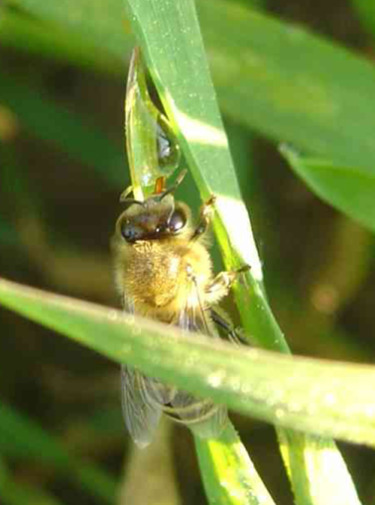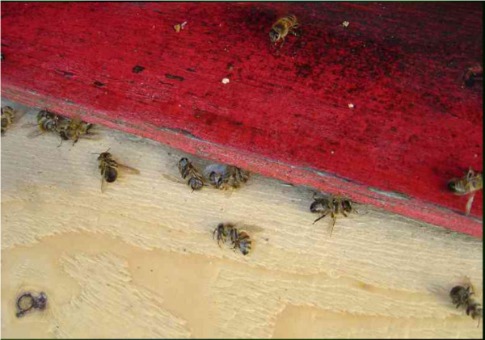Protecting BIG AG:
Civil Servants Trashed Independent Study Into Neonics With Flawed Data
How civil servants misled a government by using flawed and irrelevant data to cast doubt over an independent study into impact of neonics on bees via guttation.
In 2009, a peer reviewed, robust laboratory study raised alarm amongst beekeepers.
The study:
Girolami et al: Translocation of Neonicotinoid Insecticides From Coated
Seeds to Seedling Guttation Drops: A Novel Way of Intoxication for Bees.
Journal of Economic Entomology 2009, 102 (5), 1808-1815.
This study suggested that if bees consumed guttation drops (excretions
of xylem fluid) from corn treated with neonicotinoids), they would die in
minutes:
"The concentration of neonicotinoids in guttation drops can be near those of active ingredients commonly applied in field sprays for pest control, or even higher. When bees consume guttation drops, collected from plants grown from neonicotinoid-coated seeds, they encounter death within few minutes."
It is relevant here to point out that neonics are systemic insecticides that work by permeating the whole plant. The idea is that 'pest' invertebrates that suck on plant secretions, will be killed.
Whilst plant secretions include plant xylem, such that these insecticides would be effective for killing sap sucking 'pests', a further plant secretion is of course nectar.
Nevertheless, bees are known to drink guttation from plant stalks and leaves, and the Girolami study considered this as a potential route to poisoning bees.
A group of beekeepers in Germany were so alarmed, they conducted their own study, and captured photographic evidence:
1. Bees drinking toxic guttation fluid in a field of corn treated with neonicotinoid, Clothianidin:
 Bees drinking toxic guttation fluid.
Bees drinking toxic guttation fluid.
2. What happened at the hive in the same treated corn field:

3. More close up images at the hive in the same field:

As a result of the alarm raised, Civil Servants led by Helen Thompson of FERA conducted a review for the UK government, to see whether or not the Girolami study should give cause for alarm.
Helen Thompson's Review
To investigate whether contaminated guttation drops could be cause for concern, Thompson and her team at FERA outlined and compared 3 different studies:
- Girolami’s.
- A Swiss government field study - one that conforms to EPPO 170 standards, but is fundamentally flawed.
- A study by Shawkti looking at guttation from plants treated with a pesticide that was NOT systemic!
FERA’s treatment of the Girolami study is in contrast to their treatment of the Swiss study which is a deeply flawed as you'll see...... but first
The conclusions
A quote directly from Thompson and team's conclusions:
“Only one study (Girolami et al 2009) has shown a significant effect in honeybees but this should be treated with caution as the data were generated by feeding collected droplets directly to bees and in many cases sucrose was added to ensure the honeybees consumed the dose.”
Several points about this highly misleading and erroneous conclusion:
“Only
one study (Girolami et al 2009) has shown a significant effect in honeybees but
this should be treated with caution as the data were generated by feeding
collected droplets directly to bees and in many cases sucrose was added to
ensure the honeybees consumed the dose.”
1. Since the Shawkti study did not use a systemic insecticide (i.e. one which permeates the whole plant) it was entirely irrelevant to this report which was using tax payer's money to assess the risk of neonics to bees via guttation drops.
2. The Swiss government study courtesy of Swiss Civil Servants, was about as robust and relevant as the kind of work we can expect from Thompson and her team. (Update: not very long after producing this report and more flawed research, Thompson took up a position with Big Ag company, Syngenta. I had in fact predicted this would happen, and was not in the least bit surprised).
Thompson's erroneous criticism of Girolami study, whilst cynically failing to point out the gross neglect and flaws within the Swiss study, is outright dereliction of duty as a Civil Servant, paid by the tax payer (on a senior level salary with perks) to inform the government. I would put such people into jail for deception and fraud!
3. Given that one of the 3 studies was not relevant, and another was fundamentally flawed, it is hardly surprising that only Girolami's study showed a significant effect.
4. In FERA’s conclusion, it is made to sound that the addition of
sucrose to some of the contaminated guttation fluid combined with the direct feeding to
bees, gives reason to be suspicious of Girolami’s study – almost giving the
impression the bees are deliberately tricked into consuming the insecticide.
This is misleading:
- In actual fact, Girolami added 15% honey only to some of the samples, and other bees were fed guttation drops without it.
- In any event, the addition of honey or not made no difference to the toxic effects: if neonics were present in the guttation drops, bees were poisoned, whether or not honey was added.
5. In addition to which, the EU's regulatory laboratory tests for oral toxicity use a VERY
similar method to that implemented by Girolami in his peer reviewed study.
Helen
Thompson of FERA certainly knows this – she conducted the oral toxicity
tests on behalf of Bayer CropScience to support the DAR (EU regulatory submission) for imidacloprid. In these tests, she fed bees a test solution mixed with sucrose.
This method complies with the EU regulatory standard in EPPO 170 for Oral Toxicity tests. The test pesticides
are mixed with a sucrose solution, which is offered directly to bees via single
use feeders.
However, there is a key difference which makes Girolami's methodology far more robust than the EU regulatory tests carried about by Thompson for Bayer CropScience:
- In regulatory tests, bees are merely offered the neonicotinoid solution, and the caged bees may or may not drink it. Whether or not they do is not assessed. Any dead bees are simply counted, but we have no idea how many bees consumed the fluid.
This is especially relevant, since we also do not know other factors, such as whether or not some of the bees have a full honey stomach (in which case they may not drink).
We also do not even know whether non contaminated sucrose solution is simultaneously offered to bees in the cage (as is the case with field tests in 'tunnels').
In other words, in Thompson's tests for Bayer which were used to help the company gain approval for its poison, we cannot be sure that all of the bees consumed the insecticide.
I'm afraid I simply do not trust the civil servants executing these tests! - Girolami's test was far more robust: to assess the impact of the insecticide on bees, Girolami ensure that 100% of the test sample had indeed consumed the contaminated solution - any that did not were discarded from the study. All of the bees that consumed the neonic-laced solution, died.
What about controls in regulatory tests?
I'm afraid that within this context, controls are completely irrelevant, since we are not:
- provided with information about the selection of the bees;
- we do not know how many bees consumed which fluid, therefore a proper control has not been set up. A robust experiment should ensure that 100% of the test sample had consumed the neonic-solution, compared with the control that had not:
- we do not know whether or not bees were simultaneously offered uncontaminated sucrose solution in the test sample (deemed acceptable in EU regulatory tunnel tests).
It is absolutely appalling that civil servants have acted in such a way as to mislead government and the general public, whilst being paid to do the opposite.